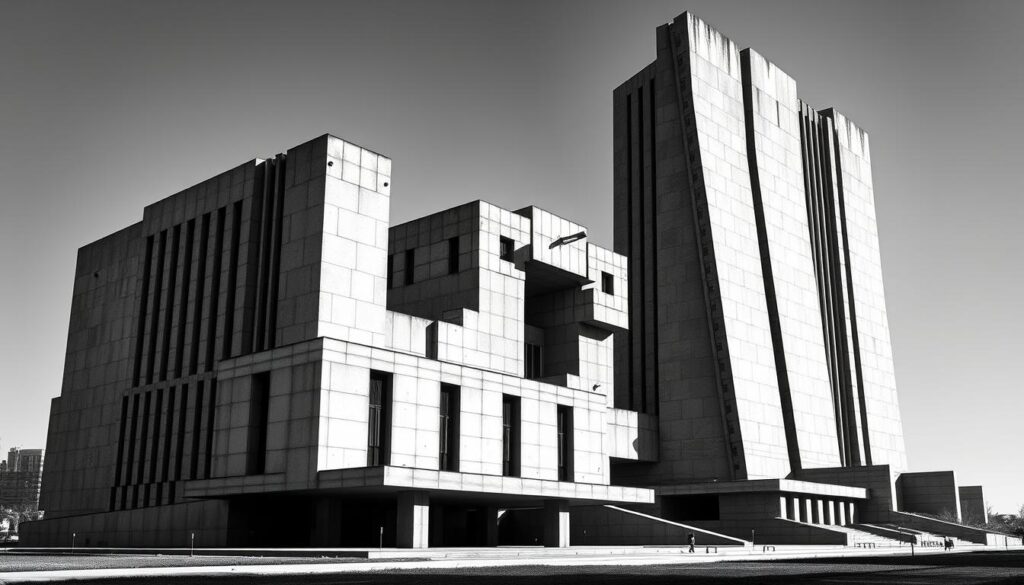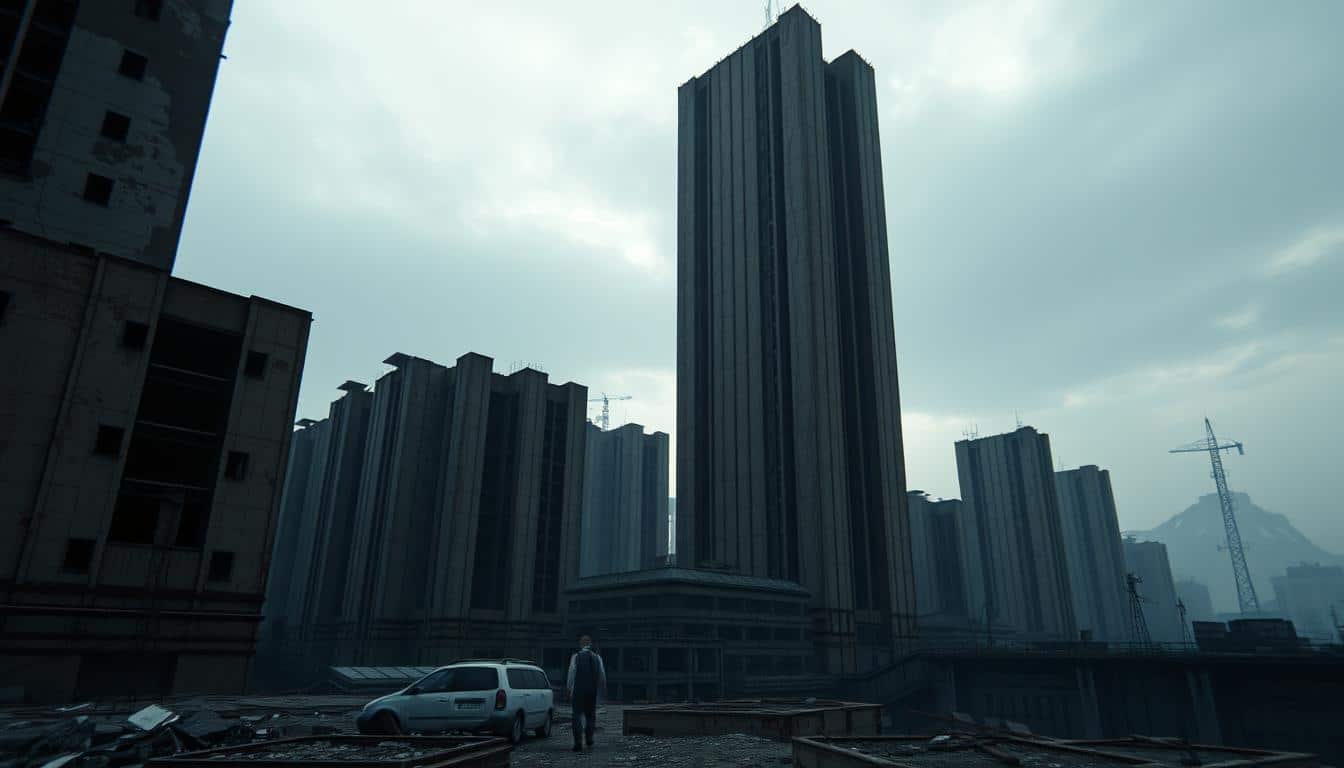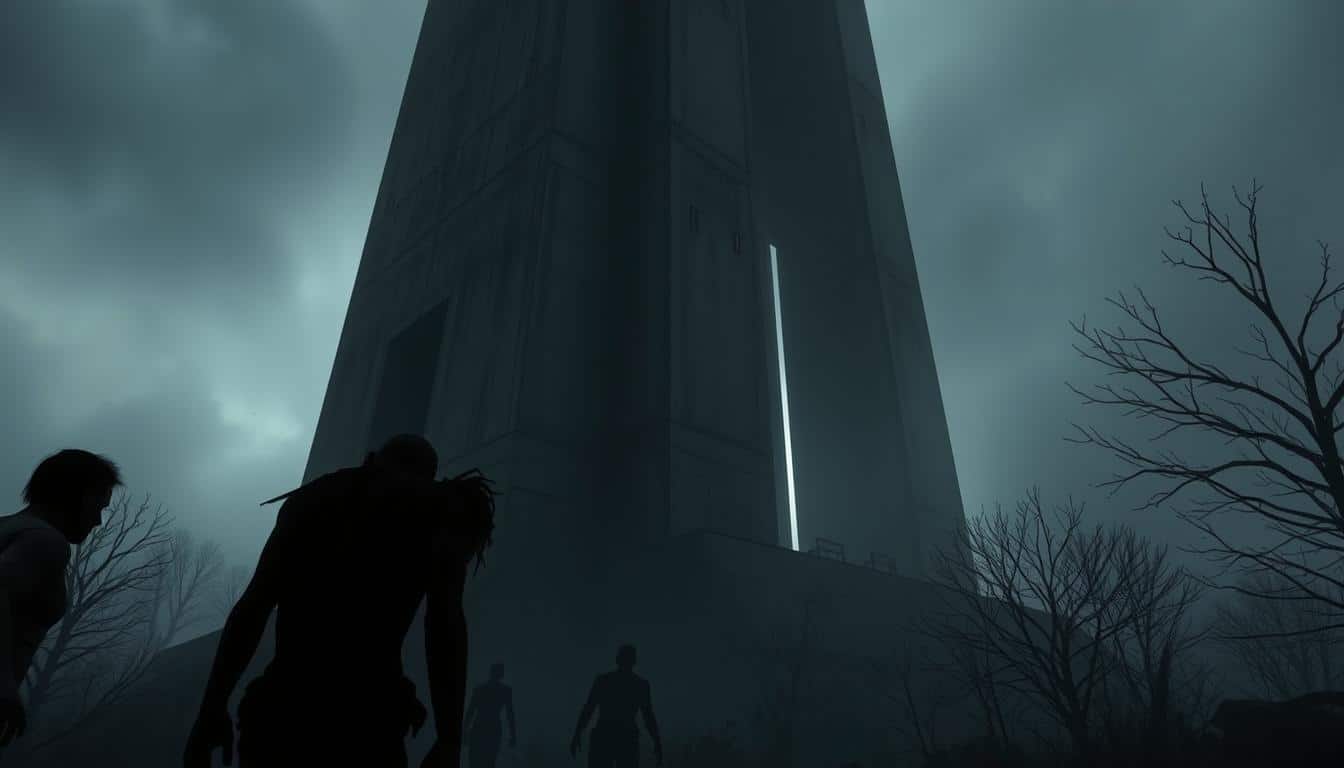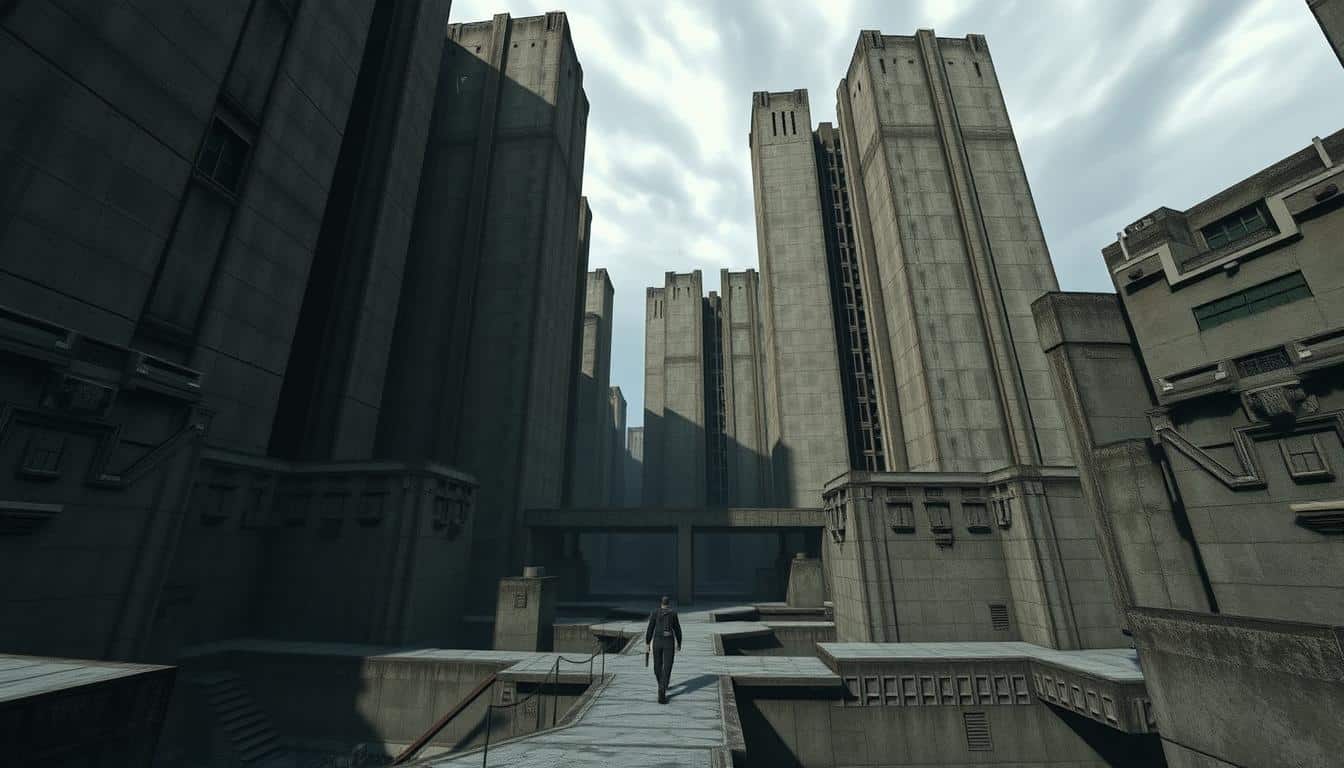Soviet Brutalism’s effect on horror games is both interesting and artistically deep. It’s known for big geometric shapes and use of raw materials. This creates a unique and intense feeling that fits horror well.
This style makes game worlds that feel both grand and scary. As people start liking these designs more, their impact on horror games grows. It’s important to see how they shape the look and feel of these games.
The Evolution of Brutalism in Architecture
Brutalism’s development is a key moment in architectural history. It mirrors wider changes in society and thinking about buildings. It started in the mid-20th century, gaining fame for public buildings from the 1950s to the 1970s, mainly in Eastern Europe. Its roots are in a move away from previous decorative styles, focusing on function and simple design instead.
This style is known for its use of raw materials, with concrete being a main feature. As times changed, Brutalism evolved, showing its ability to meet people’s needs. Architects aimed for true expression, putting the structure’s elements on display, not hiding them. This matched the post-war need for rebuilding, making Brutalism fit the era’s mood.
Over the years, Brutalism has mixed with modernism and turned towards city projects. Even though it started as a divisive style, people now see it in a new light. This has sparked fresh interest from today’s designers and critics. Brutalism’s enduring effect prompts ongoing talk about how buildings can look, work, and serve our communities.

The Aesthetic of Soviet Brutalism
Soviet Brutalism is a reminder of a time marked by huge, utilitarian buildings. It goes against traditional beauty, choosing big concrete shapes and simple lines. These show function is more important than looks. The look of Soviet buildings brings out feelings of power and control. Their big size often reflects the politics of their era.
This style has very little decoration, making it feel lonely and scary at times. It fits well in horror games. In these games, settings show our inner fears and worries about society. Brutalist architecture can make these feelings stronger. It does this as players move through spaces filled with fear.
The mix of Soviet Brutalism’s look and what it stands for is key. Buildings from this time are not just structures. They are signs of beliefs and experiences. This link between past architecture and stories today shows why Soviet Brutalism is still important in making games.
Key Characteristics of Soviet Brutalist Designs
Soviet Brutalism had a unique architectural style, focusing on function and expressive form. The buildings have plain, raw concrete surfaces. This creates a bold, cold look, which feels uninviting but interesting. This minimalist style highlights the key features of the movement.
This style values practicality and the building’s strength. The structures often comment on social or political ideas of their time. Like horror games use visuals to create tension, Soviet Brutalism uses space to stir emotions. The stark buildings remind us of eerie game settings. This helps in telling stories and drawing players in.
Iconic Examples of Soviet Brutalist Architecture
Exploring iconic Soviet Brutalism uncovers key buildings that showcase architectural boldness. These structures highlight the bold look of that era. They also reveal the society’s complex hopes and fears.
The Palace of Culture and Science in Warsaw stands out among Brutalist buildings. Often seen as Stalin’s gift, it symbolizes the hopes of a post-war society. Its grand appearance and detailed design tell a story of that period’s political atmosphere.
VDNH in Moscow is another important site. It’s an exhibition center where style meets functionality. Each pavilion reflects a different facet of Soviet life, illustrating the nation’s achievements and ambitions. The architectural choices here shed light on the cultural story of the time.
These examples show how Soviet Brutalism is tied to historical and political contexts. The continuing impact of these designs shapes our view of them today. They even influence modern digital and entertainment spaces.
Digital Brutalism: Concept and Relevance
Digital Brutalism is evolving from its architectural roots, deeply affecting video game design. It brings raw, bold features of Brutalism to digital worlds. This makes games more engaging, stirring strong feelings in players. Digital Brutalism’s power lies in turning stark beauty into a digital experience. It creates spaces that are both strange and familiar.
In the digital world, Brutalism aims for a flawless look. This is different from the aged look of real Brutalist buildings. The perfection in virtual Brutalism adds to the spookiness of horror games. It makes players feel more part of the scary stories. Combining these design elements bridges real and virtual worlds. It pushes the limits of what we can do with digital spaces.
Understanding digital Brutalism begins with its focus on geometry and form. The simplicity in its visuals reflects Brutalist architecture’s clear lines and shapes. This is used to enhance the mood in horror games. These features are perfect for creating tension and fear. It shows how space and feeling work together in games.
The Influence of Soviet Brutalist on the Visual Identity of Horror Games
The design philosophy of Soviet Brutalism greatly shapes how horror games look. This style is known for its bare concrete and large forms. It helps to create a feeling of discomfort. In horror games, using Brutalist traits makes the mood tense and scary. Players face places that make them feel alone, worried, and scared, making the game better.
How Brutalist Elements Create Tension and Fear
Brutalism’s big size is key in making players feel scared and weak. Concrete structures in the games look big and scary. Some things that make the game feel more frightening include:
- Big buildings that tower over the player.
- Empty, cold places that lack any comfort.
- Sharp designs that make the space feel strange.
By focusing on being cold and distant, the setting makes players feel more scared. The influence of Soviet Brutalism shows how loneliness and sadness can be felt in grim places. It makes the horror in games even stronger.
Soviet Imagery and Iconography in Horror Game Settings
Adding Soviet pictures and symbols makes horror games’ stories better. Soviet signs and building types add layers to the story. These things help players dive into the game’s world more fully, making the experience better. Key points include:
- Bringing in Soviet symbols that players will recognize.
- Using propaganda posters to set the historical scene and mood.
- Making spaces that show the era’s social struggles and fears.
Adding these elements helps with both the look and story of games. It helps players get a full picture of the world they’re in while playing horror games.
Case Study: HROT and Its Brutalist Influences
The indie game HROT is a great example of Brutalist design in video games. It mixes 1990s shooter game styles with Soviet architecture, making a dystopian world. This makes the game’s world feel real and fascinating.
Game Mechanics Reflecting Architectural Design
In HROT, the way you play reflects Brutalist buildings’ simple but strong style. Here’s what makes it stand out:
- Players move in a straight path, similar to the clear lines in Brutalist architecture.
- The game’s design tells a story, showing history and place without words.
- The battle parts of the game make the lonely feeling stronger, making the game more exciting.
Atmospheric Concerns in Level Design
The design of HROT’s levels makes you feel the Brutalist inspiration. It brings out feelings of being alone and trapped, fitting the game’s story. Notable features are:
- The game has complex maps that make you think of Soviet buildings.
- It uses visual hints to help players but keeps the mood heavy.
- It paces the game so you really feel the empty, stark world, pulling you in deeper.
The Role of Sound and Music in Enhancing Brutalist Visuals
In horror games inspired by Brutalism, sound is key to highlighting the visuals. The strange sounds make the game’s world feel real and scary for players. Good sound design uses creepy noises and background sounds to make the game’s grim setting more intense.
Music in games serves to deepen the mood and connect with players on an emotional level. Simple soundtracks help players focus while increasing feelings of being alone and scared. The music’s unsettling notes match the tough concrete visuals, making everything feel scarier and more intense.
Great examples of sound work can be seen in games like Resident Evil and Silent Hill. Here, the sound plays a big role in how players feel. How sound and visuals work together makes the game more engaging, showing the importance of sound in making games scary and keeping players hooked.
Cross-Cultural Perspectives: Beyond Soviet Brutalism in Horror Games
Exploring cultural influences in horror games reveals a rich landscape. Various architectural styles contribute to the immersive atmosphere. Different global perspectives inform game design, showcasing architectural diversity.
Beyond the stark lines of Soviet Brutalism, other styles lend unique horror experiences. Gothic, Art Deco, and Japanese traditional architecture are examples. They enhance storytelling and gameplay in their own ways.
Games like Resident Evil and Silent Hill show how Western Gothic elements can evoke fear. They use decaying castles and haunting landscapes. Meanwhile, Fatal Frame offers a look into Japanese culture. This game combines architecture with local folklore to boost the horror through storytelling.
This mix of architectural influences does more than make things look scary. It builds rich narratives as players explore environments reflecting different cultures. By using these varied styles, developers create gameplay that connects with people worldwide. This enriches the global horror game scene.
Conclusion
The study of Soviet Brutalism shows how it deeply influences horror games’ look. Its bold and big designs help create a spooky feel, pulling players into the game. This style does more than just make games look scary; it also shapes how they play and tell their story, making the scare feel even realer.
The way horror games look will keep changing, taking cues from all kinds of building styles. But, the strong features of Brutalist architecture will still play a big role. This mix of old and new ideas in game design makes us wonder how they will tell stories and stir feelings in future games. Developers are mixing the old with the new, promising games that both honor history and explore new ideas.
The use of Soviet Brutalist architecture gives us a special way to see how horror games have changed. It shows how game makers are using design to make games more engaging and memorable. Brutalism’s impact shows the strength of combining design with game play in the world of gaming.



